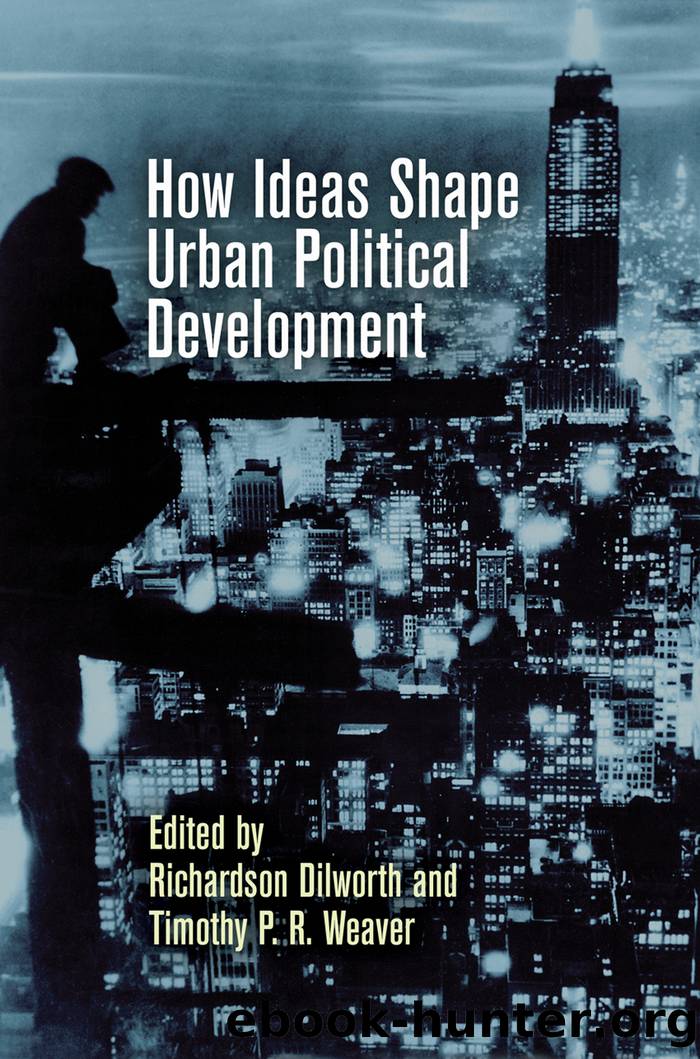How Ideas Shape Urban Political Development by Richardson Dilworth

Author:Richardson Dilworth
Language: eng
Format: epub
Publisher: University of Pennsylvania Press, Inc.
Published: 2020-01-15T00:00:00+00:00
Newark, New Jersey
In raw numbers, New Jersey has the sixth-largest immigrant population in the United States, but in terms of population share, the state has the third-largest percent of immigrants after California and New York. Brookings Institution researchers call the New York Cityânorthern New Jersey area a continuous immigrant gateway.21 Newark is the stateâs largest city, with a population of about 275,000. At 26 percent, its share of immigrants is higher than that of the state as a whole. Adjoining cities have even higher proportions of immigrants. Newarkâs immigrant groups come from Latin America, Europe, and Africa. The top ten countries of origin are Brazil, Ecuador, Portugal, the Dominican Republic, El Salvador, Ghana, Haiti, Jamaica, Nigeria, and Mexico.22
Newark is a quintessential American industrial city that thrived more or less through World War II and then entered a period of economic and population decline stemming primarily from suburbanization, economic restructuring, and racial discrimination. It is known for riots in 1967 that brought the National Guard into the city in tanks and resulted in injury, loss of life, and property destruction. Newark leaders and residents have struggled with high poverty rates, high crime rates, and attendant social problems, along with economic disinvestment. Signs of revitalization starting in the 1990s have persisted, albeit slowed by the most recent economic downturn.
Since 1970 Newark has been a majority-black city. The cityâs first black mayor was elected in the early 1970s. The city experienced population declines for forty years until around 2000, just at the time when immigration rates increased. The Latino population is now 33 percent. In a city racially segregated and organized politically by wards, this demographic change has had political consequences. Of the cityâs nine council members in 2017, three were Puerto Rican, one was Portuguese, and five were African American. As a result of immigration, the ethnic backgrounds of the cityâs Latinos are shifting, reflecting a declining dominance of Puerto Ricans and a growth in Central and South Americans.
Until recently, Newark city leaders had been somewhat passive in terms of explicit immigrant policy. The previous mayor, Cory Booker, emphasized early in his first term that Newark was a âsanctuary city,â meaning that city agencies were prohibited from asking about legal status or sharing that information with federal agencies. On the other hand, advocates said during Bookerâs tenure that few people knew about this ordinance. Booker was sympathetic but ultimately did not change policies in response to advocacy efforts on behalf of undocumented workers regarding license requirements for street vendors and efforts to create a hiring hall where NGOs could link workers with employers and provide a check on employersâ exploitation of undocumented immigrant workers. Lack of legal status remains a barrier to earning a livelihood in the city.
Mayor Booker created the African Commission, a volunteer body aimed at raising awareness of African culture and African immigrants in Newark. In the 2014 mayoral election that brought Ras Baraka into the mayorâs office, immigration was not featured in candidatesâ policy agendas. However, in the
Download
This site does not store any files on its server. We only index and link to content provided by other sites. Please contact the content providers to delete copyright contents if any and email us, we'll remove relevant links or contents immediately.
The Secret History by Donna Tartt(18843)
The Social Justice Warrior Handbook by Lisa De Pasquale(12141)
Thirteen Reasons Why by Jay Asher(8792)
This Is How You Lose Her by Junot Diaz(6792)
Weapons of Math Destruction by Cathy O'Neil(6142)
Zero to One by Peter Thiel(5685)
Beartown by Fredrik Backman(5594)
The Myth of the Strong Leader by Archie Brown(5424)
The Fire Next Time by James Baldwin(5248)
How Democracies Die by Steven Levitsky & Daniel Ziblatt(5127)
Promise Me, Dad by Joe Biden(5087)
Stone's Rules by Roger Stone(5026)
A Higher Loyalty: Truth, Lies, and Leadership by James Comey(4842)
100 Deadly Skills by Clint Emerson(4840)
Rise and Kill First by Ronen Bergman(4701)
Secrecy World by Jake Bernstein(4643)
The David Icke Guide to the Global Conspiracy (and how to end it) by David Icke(4624)
The Farm by Tom Rob Smith(4434)
The Doomsday Machine by Daniel Ellsberg(4415)
